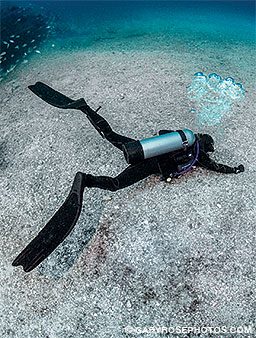My trip to the Revillagigedo Archipelago was everything that I had hoped for — a beautiful liveaboard and several dives every day at all the famous sites. It was a wide-angle photographer’s dream, with appearances by sharks, manta rays, dolphins and too many fish species to count. I never expected to find myself upside down with my legs floating above me, gripping a tiny pinch of volcanic rock and desperately trying to stay on the bottom, with my life in real danger.
A diver for more than 46 years and an open-water instructor since 2014, I have logged thousands of dives in many different conditions and am active and maintain a vigorous exercise routine. I frequently dive with a large underwater housing with two strobes and am comfortable using my equipment like a big sail, changing its angle and position to enable me to effortlessly drift with the current.
At Revillagigedo, however, the strong and persistent currents made my camera setup act as additional resistance when I needed to kick into the flow. To decrease my underwater profile and reduce drag, I decided to carry only 2 pounds of weight instead of my usual 6 pounds so I would not have to inflate my buoyancy compensator. Before the next dive I noticed that the dive operators had given me an aluminum tank rather than the steel one I had been using all week. To compensate for the lighter tank, I was about to add back the weight that I had removed but was distracted when another diver needed my help with his tank.
A few minutes later I back-rolled off the dive tender, forgetting to add back the weight. As I cleared my bubbles, I intended to head straight down as usual, but I couldn’t descend at all. I shifted to a freediving entry, kicking excessively hard and pulling with my free arm. When I finally got to 30 feet, I didn’t feel any more pull to the surface and thought all would be well.
Twenty minutes later, I was kicking into the current at 75 feet when I felt a gentle and constant upward tug, which was exacerbated by the upwelling current. My legs began to rise a little, and I realized what was happening: The extra work had increased my air consumption, and I remembered that I hadn’t replaced my weights. I always teach my students that decreasing air in an aluminum tank causes a linear increase in buoyancy, and now I had forgotten that simple lesson.
The upward pull was getting intense, and I couldn’t find any rocks or chunks of coral to pick up from the volcanic bottom for extra weight. My dive buddy wasn’t paying attention to what was happening to me and was too far away for me to risk the swim. Before the current pulled me toward the surface, I was able to grab a tiny ridge of an old lava flow and hang on for dear life.

I was thinking about every emergency scenario for this situation when the divemaster showed up at my side. He quickly understood my communication and motioned for me to stay put. My search for extra weight had left me with only 500 psi in my tank, so I tried to decrease my breathing and slow my heart rate, hoping to reduce my air consumption. The powerful upwelling current was forcing my legs straight up, and my fingers, acting as a fulcrum, were tiring from my death grip on the tiny ridge.
I was contemplating how forcefully I would need to exhale on an uncontrolled free ascent and wondering if I could make it to the surface. My mind was racing to think of any other possible solutions. The divemaster was gone for what seemed like an eternity but was probably only a few minutes. I was down to 300 psi when he returned carrying a huge piece of volcanic pumice. Despite the size, it seemed to weigh only 7 or 8 pounds — just enough to let me make a controlled ascent. I started slowly ascending, hugging the pumice the entire way and during my safety stop. At the surface, I let it go and watched my lifesaver rock drift to the bottom. Intact and now safe, I climbed onto the dive tender.
To add insult to (almost) injury, I was on the liveaboard to teach a dive medicine course, which included a section on buoyancy control. That evening I added a mea culpa explanation of the incident to my usual lecture.
Where did things go wrong? The two triggers for my incident were improper weighting and strong current, and the disabling agent was my loss of buoyancy control. I should have ended my dive when I had to work so hard to descend. My buddy and I should have been close enough to offer quick assistance, especially given the remote location. By remaining calm, communicating and working as a team with my alert divemaster, we averted the next two steps: disabling injury and death.
All diving has risks. To mitigate them, we must always pay attention to the details. The predive safety check is of utmost importance to help avoid a dive accident. The key elements are for each buddy to check the other’s BCD, weights, releases and air, and then give a final check and decisive OK. I could have avoided the entire incident had I adhered to my predive safety check and not gotten distracted, and I should have performed the safety check again before getting in the water.
Staying calm and utilizing our combined experience helped me and my divemaster avert a disastrous outcome.
© Alert Diver — Q1 2021